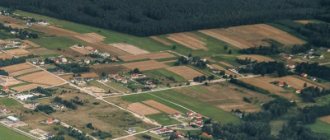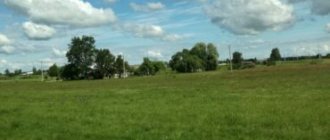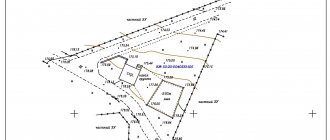Types of permitted land use
VRI is one of the main characteristics that is prescribed in the Cadastral passport for real estate. Its primary source is the intended purpose of the territory. The type of operation of the plot determines its cadastral value, from which the land tax is calculated.
The legislation distinguishes three types - the main, auxiliary and conditionally permitted type of use of the land plot.
Main Use
The main VRI in land legislation:
- Agriculture.
- Individual housing construction.
- Subsidiary farm.
- Farms.
- Industrial zones.
- Water objects.
- Forest lands.
- Public areas.
For populated areas, the VRI will be as follows: individual housing construction, private plots and dacha development (gardening, horticulture, livestock breeding, etc.). The purposes of use are individual, for the family.
Thus, if a plot of land is located on an area intended for residential development, it can only be used if a residential building is built on it and a subsidiary farm is maintained. Gardening, gardening, etc. are also conditionally permitted activities here. It is prohibited to build commercial facilities in such an area.
Conditionally permitted use
VRI works only under clearly defined conditions and is additional to the main type. For any territory, state authorities, according to urban planning regulations, assign a list of conditionally permitted exploitation options. Using this list, you can determine whether construction work is allowed in a given area - residential building, commercial premises, etc.
Auxiliary application category
The list of auxiliary buildings includes buildings and structures that help operate the main ones. These include:
- Driveways.
- Fencing.
- Garage.
- Outbuilding.
- Farm premises.
- Transformer booth.
- Parking area.
- Children playground.
- Security post, barrier.
- Technical area.
Auxiliary VRI are attached not only to the main ones, but also to conditionally permitted ones, always as a supplement; they cannot be basic.
Reserve lands and protected areas
These two categories of land are withdrawn from circulation. Lands of specially protected natural areas are, as a rule, state property, although the law allows these areas to be privately owned. There have simply been no such precedents in Russia.
Lands recognized as particularly valuable to society are transferred from one category to another and withdrawn from circulation and economic use. Their transfer back to another category is not provided for by law. Reserve lands cannot be used for economic purposes, but can be transferred to another category and with a certain permitted use.
General provisions on land use
Misuse of plots is prohibited by law. The permitted method is indicated in the documentation for the land: Cadastral passport and Certificate of ownership. If the land according to the papers is intended for residential development and subsidiary farming, industrial and administrative buildings cannot be built on it.
If the owner intends to change the nature of land use, to obtain permission it is necessary to contact the appropriate service and amend the allotment passport. If it is impossible to change the method of using the territory, you will have to sell the current one and purchase a new one.
The main document that guides government agencies in this regard is the urban planning plan - it indicates the goals and plans for the development of territories in a city or rural settlement. At the municipal level, rules for development and land use are established. They are based not only on the Land Code of the Russian Federation, but also on the economy and climate of the region.
They define:
- General directions of development of the region.
- Breakdown into zones (for residential construction, manufacturing, infrastructure, agriculture, etc.) with a description of the functionality and prohibitions for each.
- List of environmental protection measures.
- Borders of settlements.
Thanks to a clear division of the general territory into industrial, residential, administrative, agricultural, forest, environmental and other zones, it is possible to achieve order and the most rational use of land - conditionally permitted uses depend on them. The most commonly used functional zone is an area near a populated area.
Where are URVI indicated?
The main document of the municipality regulating urban development within its boundaries is the Land Use and Development Rules. Therefore, for construction on a specific site, it is necessary to familiarize yourself with them in advance in order to avoid unpleasant situations later.
Often such rules are called a “land construction passport”, which contains information about the allotment. They include all permissible types of its use (including conditionally permitted), as well as restrictions on the land. There is also a topographical diagram with construction zones, red lines, etc.
An urban development plan is issued to the land owner only on the basis of an application submitted to the local government body. Preparation takes 20 working days, calculated from the date of application, and is issued free of charge (Article 57 3 of the Town Planning Code).
Conditionally permitted types of land use in 2021
The main difference between a conditional type of use is that in order to assign it to an object, additional approval is required from the government authority. The main VRI is appointed for the allotment immediately, without additional applications and commission hearings.
For example, a retail facility with an area of two hundred square meters may have the following conditional types of purpose:
- Administrative institution.
- Office space.
- Trade pavilion.
- Utility room.
- Stock.
This type of premises can also be used for hospitals, gyms or swimming pools.
For an allotment in rural areas, in addition to the main one (LPH), conditional types of exploitation can be:
- Breeding large and small livestock.
- Poultry farming.
- Cultivation of a garden and vegetable garden.
- Floriculture.
In this case, plots are divided into household plots and field plots. In the first case, it is allowed to build cottages, country houses, and garages. Any buildings with a foundation are prohibited in the field.
Conditionally permitted type of land plot: procedure for assignment or change
In order to change or assign a new condition for the use of a land plot, it is necessary to go through the permit and registration procedure (regulated by the Town Planning Code of the Russian Federation):
- It is necessary to collect a complete package of documents confirming ownership of the property.
- With the collected package, contact the local administration and write an application.
- Administration officials organize a commission and public hearings on the case.
- Based on them, a conclusion is made - the applicant is given consent or refusal to provide a conditionally permitted VRI.
- If the decision is positive, the administration sends the information to the Cadastral Chamber, where it is recorded and entered into the Rosreestr.
- After this, the owner can receive a modified EGRN extract and use the land for its intended purpose.
An example would be the conversion of agricultural land into land for residential construction.
Loading…
Too long?
Reload document
| Open in new tab
What is the category of land (purpose)
The division of land into categories is a consequence of the zoning of territories and the determination of state strategy. For example, agricultural lands include areas with fertile soil, forest lands should be covered with forest vegetation, and specially protected natural areas should be of great value for science and preserving the optimal properties of the ecological environment.
In accordance with the norms of the Land Code, the belonging of land to a category is the legal regime for its use. From this we can conclude that the category of land is a legally established description of standard properties.
Please note that the category of land and the intended purpose are equivalent concepts; you can use both the first and the second. The Land Code of the Russian Federation defines 7 categories:
- Lands of populated areas (settlements);
- Agricultural land (agricultural);
- Special purpose lands (for example, lands occupied for industrial and energy facilities, communications, country security facilities, etc.);
- Lands of specially protected natural areas (SPNA);
- Forest fund lands;
- Water fund lands;
- State reserve lands.
The last category is distinguished not so much by the principle of use as by underuse. In a large country there will always be land that is not in demand in the national economic system - this is the country’s land reserve. The greatest turnover of land is typical for the categories of agricultural purposes and settlements. In addition, the opportunity has arisen to transfer ownership of forest lands, but citizens are in no hurry to take advantage of it.
Next, we will consider each category and the types of permitted use included in it in more detail.
Consolidation of several plots and VRI
You can merge areas that have at least one border. By law they are recognized as adjacent. Conditions under which merger is permitted:
- Consent of all owners.
- Each plot has a cadastral passport (you must take an extract from the Unified State Register of Real Estate).
- The same type of permitted use (indicated in the USRN extract).
- Same land category.
- The plots correspond to the maximum minimum and maximum indicators in a given location area.
If the VRI of the plots are different and the goal is to combine them, you can try to apply to change the type of operation of one of the plots. In order to combine territories, you must contact a cadastral engineer with a previously collected package of documents. He will draw up a plan, which, along with the application, the owners submit to the Rosreestr institution or the Multifunctional Center.
Grounds and procedure for assigning VRI
The procedure for obtaining a permit is multi-stage and is carried out in accordance with the provisions of Art. 39, art. 5.1 Town Planning Code of the Russian Federation.
Submitting an application
An organization or citizen must first contact the commission operating in each municipality that considers issues regarding the rules of development and land use. Usually the application is accompanied by documents and justifications that describe all the advantages of the possible use of the site according to the conditionally permitted use.
Organizing and conducting public or public hearings
Based on the application received, the commission organizes open hearings , access to which is allowed to all persons. The commission publishes information in the media about the date and time, location of the hearing (determined by the commission), and also indicates in the announcement information about the person requesting permission, about the land plot, and about the requested type of use.
In addition, messages about upcoming hearings are sent via mail to the owners of all adjacent land plots.
At the hearing, after the applicant and members of the commission have given the floor on the issue under discussion, a conversation is held with the population. Citizens and representatives of organizations can express their opinions and make recommendations regarding the granting of rights.
The hearings end with a vote, and based on its results, a conclusion is drawn up with two possible decisions:
- recommend granting the applicant the right to a conditionally permitted use;
- do not recommend granting the applicant the right to conditionally permitted use.
Conclusions on the results of the public discussion are published in the media.
Important! The deadline for this procedure is set: one month, calculated from the date of publication of the notice of the hearings until the date of publication of the conclusion on their results.
Preparation of recommendations by the commission
The results of the public discussion are discussed at a meeting of the commission, but the applicant is not allowed to attend this meeting. The commission also forms its recommendations and makes a conclusion about the advisability or impossibility of granting permission.
After this, all materials (findings of the hearings, recommendations of the commission) are sent to the head of the municipality for consideration and making a final decision.
Didn't find the answer to your question? Check out other articles on similar topics:
- VRI for private household plots.
- Changing the type of permitted use of memory.
- By whom and how is VRI installed?
- What are the differences and which is better:
- Peasant farms and private household plots.
- Private household plots and individual housing construction.
- SNT and individual housing construction.
Change of copyright holder and URVI
The legislation applies rules for changing ownership when the intended purpose of the plot is documented:
- Since the URVI is tied to the property, it does not change when the owner changes.
- The type of use changes if, upon transfer of ownership rights, its validity period expires.
- Simultaneously with the transfer of ownership, an application to change the ID can be submitted.
When dividing one plot into several, the conditionally permitted type of use of the land does not change.
VRI classifier
In 2014, in order to unify documentation on territory planning throughout Russia, a Unified Classifier of Types of Use of Land Plots was approved. It contains common language for all VRIs, which will be used in all municipalities after the transition period.
Previously, such a classifier did not exist; local authorities independently formulated acceptable VRI, which led to both inconsistency between different cities and many problems in interpreting the content of VRI. This became an obstacle in obtaining construction permits for some developers.
However, the classification of a specific VRI as a main, conditionally permitted, auxiliary type within the zones still remains within the exclusive competence of local authorities. You can get acquainted with the full list of VRI by referring to the order of the Ministry of Economic Development of the Russian Federation dated September 1, 2014 No. 540.










